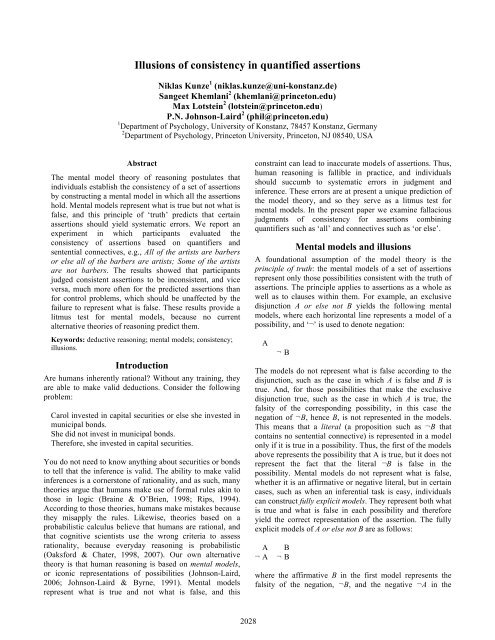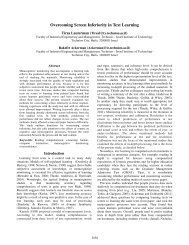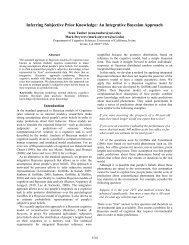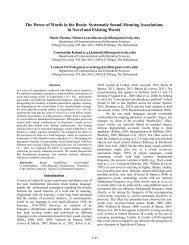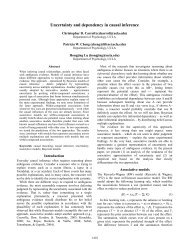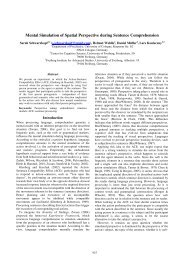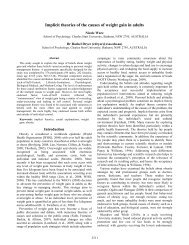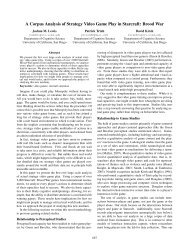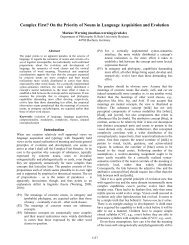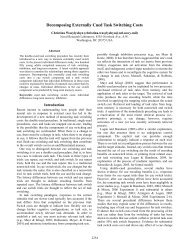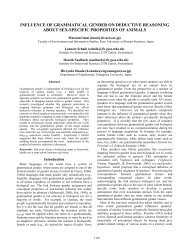Illusions of consistency in quantified assertions
Illusions of consistency in quantified assertions
Illusions of consistency in quantified assertions
You also want an ePaper? Increase the reach of your titles
YUMPU automatically turns print PDFs into web optimized ePapers that Google loves.
<strong>Illusions</strong> <strong>of</strong> <strong>consistency</strong> <strong>in</strong> <strong>quantified</strong> <strong>assertions</strong><br />
Niklas Kunze 1 (niklas.kunze@uni-konstanz.de)<br />
Sangeet Khemlani 2 (khemlani@pr<strong>in</strong>ceton.edu)<br />
Max Lotste<strong>in</strong> 2 (lotste<strong>in</strong>@pr<strong>in</strong>ceton.edu)<br />
P.N. Johnson-Laird 2 (phil@pr<strong>in</strong>ceton.edu)<br />
1 Department <strong>of</strong> Psychology, University <strong>of</strong> Konstanz, 78457 Konstanz, Germany<br />
2 Department <strong>of</strong> Psychology, Pr<strong>in</strong>ceton University, Pr<strong>in</strong>ceton, NJ 08540, USA<br />
Abstract<br />
The mental model theory <strong>of</strong> reason<strong>in</strong>g postulates that<br />
<strong>in</strong>dividuals establish the <strong>consistency</strong> <strong>of</strong> a set <strong>of</strong> <strong>assertions</strong><br />
by construct<strong>in</strong>g a mental model <strong>in</strong> which all the <strong>assertions</strong><br />
hold. Mental models represent what is true but not what is<br />
false, and this pr<strong>in</strong>ciple <strong>of</strong> ‘truth’ predicts that certa<strong>in</strong><br />
<strong>assertions</strong> should yield systematic errors. We report an<br />
experiment <strong>in</strong> which participants evaluated the<br />
<strong>consistency</strong> <strong>of</strong> <strong>assertions</strong> based on quantifiers and<br />
sentential connectives, e.g., All <strong>of</strong> the artists are barbers<br />
or else all <strong>of</strong> the barbers are artists; Some <strong>of</strong> the artists<br />
are not barbers. The results showed that participants<br />
judged consistent <strong>assertions</strong> to be <strong>in</strong>consistent, and vice<br />
versa, much more <strong>of</strong>ten for the predicted <strong>assertions</strong> than<br />
for control problems, which should be unaffected by the<br />
failure to represent what is false. These results provide a<br />
litmus test for mental models, because no current<br />
alternative theories <strong>of</strong> reason<strong>in</strong>g predict them.<br />
Keywords: deductive reason<strong>in</strong>g; mental models; <strong>consistency</strong>;<br />
illusions.<br />
Introduction<br />
Are humans <strong>in</strong>herently rational? Without any tra<strong>in</strong><strong>in</strong>g, they<br />
are able to make valid deductions. Consider the follow<strong>in</strong>g<br />
problem:<br />
Carol <strong>in</strong>vested <strong>in</strong> capital securities or else she <strong>in</strong>vested <strong>in</strong><br />
municipal bonds.<br />
She did not <strong>in</strong>vest <strong>in</strong> municipal bonds.<br />
Therefore, she <strong>in</strong>vested <strong>in</strong> capital securities.<br />
You do not need to know anyth<strong>in</strong>g about securities or bonds<br />
to tell that the <strong>in</strong>ference is valid. The ability to make valid<br />
<strong>in</strong>ferences is a cornerstone <strong>of</strong> rationality, and as such, many<br />
theories argue that humans make use <strong>of</strong> formal rules ak<strong>in</strong> to<br />
those <strong>in</strong> logic (Bra<strong>in</strong>e & O’Brien, 1998; Rips, 1994).<br />
Accord<strong>in</strong>g to those theories, humans make mistakes because<br />
they misapply the rules. Likewise, theories based on a<br />
probabilistic calculus believe that humans are rational, and<br />
that cognitive scientists use the wrong criteria to assess<br />
rationality, because everyday reason<strong>in</strong>g is probabilistic<br />
(Oaksford & Chater, 1998, 2007). Our own alternative<br />
theory is that human reason<strong>in</strong>g is based on mental models,<br />
or iconic representations <strong>of</strong> possibilities (Johnson-Laird,<br />
2006; Johnson-Laird & Byrne, 1991). Mental models<br />
represent what is true and not what is false, and this<br />
2028<br />
constra<strong>in</strong>t can lead to <strong>in</strong>accurate models <strong>of</strong> <strong>assertions</strong>. Thus,<br />
human reason<strong>in</strong>g is fallible <strong>in</strong> practice, and <strong>in</strong>dividuals<br />
should succumb to systematic errors <strong>in</strong> judgment and<br />
<strong>in</strong>ference. These errors are at present a unique prediction <strong>of</strong><br />
the model theory, and so they serve as a litmus test for<br />
mental models. In the present paper we exam<strong>in</strong>e fallacious<br />
judgments <strong>of</strong> <strong>consistency</strong> for <strong>assertions</strong> comb<strong>in</strong><strong>in</strong>g<br />
quantifiers such as ‘all’ and connectives such as ‘or else’.<br />
Mental models and illusions<br />
A foundational assumption <strong>of</strong> the model theory is the<br />
pr<strong>in</strong>ciple <strong>of</strong> truth: the mental models <strong>of</strong> a set <strong>of</strong> <strong>assertions</strong><br />
represent only those possibilities consistent with the truth <strong>of</strong><br />
<strong>assertions</strong>. The pr<strong>in</strong>ciple applies to <strong>assertions</strong> as a whole as<br />
well as to clauses with<strong>in</strong> them. For example, an exclusive<br />
disjunction A or else not B yields the follow<strong>in</strong>g mental<br />
models, where each horizontal l<strong>in</strong>e represents a model <strong>of</strong> a<br />
possibility, and ‘¬’ is used to denote negation:<br />
A<br />
¬ B<br />
The models do not represent what is false accord<strong>in</strong>g to the<br />
disjunction, such as the case <strong>in</strong> which A is false and B is<br />
true. And, for those possibilities that make the exclusive<br />
disjunction true, such as the case <strong>in</strong> which A is true, the<br />
falsity <strong>of</strong> the correspond<strong>in</strong>g possibility, <strong>in</strong> this case the<br />
negation <strong>of</strong> ¬B, hence B, is not represented <strong>in</strong> the models.<br />
This means that a literal (a proposition such as ¬B that<br />
conta<strong>in</strong>s no sentential connective) is represented <strong>in</strong> a model<br />
only if it is true <strong>in</strong> a possibility. Thus, the first <strong>of</strong> the models<br />
above represents the possibility that A is true, but it does not<br />
represent the fact that the literal ¬B is false <strong>in</strong> the<br />
possibility. Mental models do not represent what is false,<br />
whether it is an affirmative or negative literal, but <strong>in</strong> certa<strong>in</strong><br />
cases, such as when an <strong>in</strong>ferential task is easy, <strong>in</strong>dividuals<br />
can construct fully explicit models. They represent both what<br />
is true and what is false <strong>in</strong> each possibility and therefore<br />
yield the correct representation <strong>of</strong> the assertion. The fully<br />
explicit models <strong>of</strong> A or else not B are as follows:<br />
A B<br />
¬ A ¬ B<br />
where the affirmative B <strong>in</strong> the first model represents the<br />
falsity <strong>of</strong> the negation, ¬B, and the negative ¬A <strong>in</strong> the
second model represents the falsity <strong>of</strong> affirmative, A. As<br />
these models show, the disjunction is equivalent to the<br />
biconditional: A if and only if B. However, very few people<br />
grasp the equivalence, because it is evident only to those<br />
who envisage what is false and construct fully explicit<br />
models.<br />
The pr<strong>in</strong>ciple <strong>of</strong> truth may seem like a useful compromise<br />
to reduce the load on work<strong>in</strong>g memory, but it has an<br />
unexpected consequence: it predicts illusions, i.e.,<br />
judgments and <strong>in</strong>ferences that are compell<strong>in</strong>g but erroneous<br />
(Johnson-Laird & Savary, 1999). <strong>Illusions</strong> can occur when<br />
<strong>in</strong>dividuals assess conclusions, make <strong>in</strong>ferences, or evaluate<br />
the <strong>consistency</strong> <strong>of</strong> a set <strong>of</strong> <strong>assertions</strong>. For example, consider<br />
this problem:<br />
There is a p<strong>in</strong> and/or a bolt on the table, or else a bolt and<br />
a nail on the table.<br />
There is a bolt and a nail on the table.<br />
Is it possible that both <strong>assertions</strong> could be true at the same<br />
time?<br />
Reasoners <strong>in</strong> one study overwhelm<strong>in</strong>gly responded ‘yes’<br />
(Johnson-Laird, Legrenzi, Girotto, & Legrenzi, 2000), but<br />
the response is a fallacy predicted by the pr<strong>in</strong>ciple <strong>of</strong> truth.<br />
It is a fallacy because ‘or else’ <strong>in</strong> the first premise is an<br />
exclusive disjunction, i.e., if one clause <strong>of</strong> the disjunction is<br />
true, the other must be false. Hence, the truth <strong>of</strong> the second<br />
premise, there is a bolt and a nail on the table, implies that<br />
both clauses <strong>in</strong> the first premise are true. And that<br />
contravenes the mean<strong>in</strong>g <strong>of</strong> ‘or else’, which means that the<br />
two <strong>assertions</strong> cannot be true at the same time. However,<br />
reasoners do not grasp this <strong>in</strong><strong>consistency</strong> and <strong>in</strong>stead<br />
<strong>in</strong>correctly judge the two <strong>assertions</strong> to be consistent.<br />
Previous studies have corroborated the existence <strong>of</strong><br />
illusory deductions from disjunctive and biconditional<br />
premises (Johnson-Laird & Savary, 1999). They have also<br />
corroborated them <strong>in</strong> s<strong>in</strong>gly <strong>quantified</strong> premises (Yang &<br />
Johnson-Laird, 2000). But, no study has exam<strong>in</strong>ed the<br />
<strong>in</strong>teraction between connectives and quantifiers. Our aim<br />
was accord<strong>in</strong>gly to test whether illusions also occurred <strong>in</strong> a<br />
new doma<strong>in</strong>: the evaluation <strong>of</strong> the <strong>consistency</strong> <strong>of</strong> <strong>assertions</strong><br />
that depend on both quantifiers and connectives (as <strong>in</strong><br />
Problem 1 below).<br />
<strong>Illusions</strong> with <strong>quantified</strong> <strong>assertions</strong><br />
Our experiment exam<strong>in</strong>ed two sorts <strong>of</strong> <strong>assertions</strong> that should<br />
yield illusions: exclusive disjunctions <strong>of</strong> <strong>quantified</strong><br />
<strong>assertions</strong>, such as All the A are B or else some <strong>of</strong> the B are<br />
A, and biconditionals <strong>of</strong> <strong>quantified</strong> <strong>assertions</strong>, such as All <strong>of</strong><br />
the A are B if and only if All <strong>of</strong> the B are A. Half <strong>of</strong> the<br />
problems used <strong>in</strong> the study were those that the pr<strong>in</strong>ciple <strong>of</strong><br />
truth predicts should yield illusory judgments <strong>of</strong><br />
<strong>consistency</strong>, and the other half were those that the pr<strong>in</strong>ciple<br />
<strong>of</strong> truth predicts should yield correct responses. Here is an<br />
example <strong>of</strong> an illusory problem based on an exclusive<br />
disjunction:<br />
2029<br />
1. Illusion (disjunction)<br />
All <strong>of</strong> the artists are barbers or else some <strong>of</strong> the barbers<br />
are artists.<br />
All <strong>of</strong> the barbers are artists.<br />
Is it possible for both statements to be true at the same<br />
time?<br />
The disjunction yields two mental models that represent the<br />
two clauses (All <strong>of</strong> the artists are barbers and Some <strong>of</strong> the<br />
barbers are artists). Each model conta<strong>in</strong>s a set <strong>of</strong><br />
<strong>in</strong>dividuals, where each l<strong>in</strong>e represents an <strong>in</strong>dividual and<br />
denotes the <strong>in</strong>dividual’s properties. We lay out the two<br />
models as follows:<br />
1. 2.<br />
[artist] barber barber artist<br />
[artist] barber barber artist<br />
barber<br />
These models represent each set by a small but arbitrary<br />
number <strong>of</strong> <strong>in</strong>dividuals (two or three <strong>in</strong> the present models),<br />
and the square brackets denote that a set has been<br />
represented exhaustively (cf. the notion <strong>of</strong> ‘distribution’ <strong>in</strong><br />
logic). One consequence <strong>of</strong> these exhaustively represented<br />
properties is that they cannot be added to new <strong>in</strong>dividuals <strong>in</strong><br />
the model (see, e.g., Johnson-Laird, 2006). So, you cannot<br />
add <strong>in</strong>stances <strong>of</strong> artists that are not barbers to the first<br />
model.<br />
Consider the first mental model, which represents the first<br />
clause <strong>of</strong> the disjunction, All <strong>of</strong> the artists are barbers. The<br />
second assertion <strong>in</strong> the problem, All <strong>of</strong> the barbers are<br />
artists, is true <strong>in</strong> this model. The model theory predicts that<br />
<strong>in</strong>dividuals judge a set <strong>of</strong> <strong>assertions</strong> to be consistent if all<br />
the <strong>assertions</strong> hold <strong>in</strong> at least one mental model. Hence,<br />
people should judge that the two <strong>assertions</strong> are consistent.<br />
However, this judgment is flawed. The pr<strong>in</strong>ciple <strong>of</strong> truth<br />
predicts that the mental models represent the truth <strong>of</strong> each<br />
clause <strong>in</strong> an exclusive disjunction, but not the concurrent<br />
falsity <strong>of</strong> the other clause. Suppose that the first clause <strong>in</strong><br />
the disjunction, All <strong>of</strong> the artists are barbers, is true. Hence,<br />
the second clause must be false, i.e., none <strong>of</strong> the barbers is<br />
an artist. This case is <strong>in</strong>consistent with the first clause <strong>of</strong> the<br />
disjunction, and so it is impossible. Now suppose that the<br />
second clause <strong>of</strong> the disjunction is true, i.e., some <strong>of</strong> the<br />
barbers are artists. In this case, it must be false that all <strong>of</strong> the<br />
artists are barbers, i.e., at least some <strong>of</strong> them are not barbers.<br />
So, we have the conjunction <strong>of</strong> at least some <strong>of</strong> the barbers<br />
are artists and at least some <strong>of</strong> the artists are not barbers.<br />
There is accord<strong>in</strong>gly just one fully explicit model <strong>of</strong> the<br />
disjunction:<br />
artist barber<br />
artist barber<br />
barber<br />
artist ¬barber<br />
The second assertion <strong>in</strong> the problem, all the barbers are<br />
artists, is accord<strong>in</strong>gly <strong>in</strong>consistent with this model, and the
correct evaluation <strong>of</strong> the two <strong>assertions</strong> is that they are<br />
<strong>in</strong>consistent.<br />
The same compound assertion used <strong>in</strong> (1) yields a control<br />
problem, as <strong>in</strong> (1’):<br />
1’. Control (disjunction)<br />
All <strong>of</strong> the artists are barbers or else some <strong>of</strong> the barbers<br />
are artists.<br />
None <strong>of</strong> the barbers is an artist.<br />
Is it possible for both statements to be true at the same<br />
time?<br />
The second assertion, none <strong>of</strong> the barbers is an artist, is<br />
<strong>in</strong>consistent with the mental models above, and so the<br />
theory predicts that <strong>in</strong>dividuals should respond that the two<br />
<strong>assertions</strong> are <strong>in</strong>consistent. In this case, they will be correct,<br />
because the second assertion is also <strong>in</strong>consistent with the<br />
fully explicit model above.<br />
An example <strong>of</strong> an illusory problem based on a<br />
biconditional assertion is:<br />
2. Illusion (biconditional)<br />
All <strong>of</strong> the artists are barbers if and only if all <strong>of</strong> the<br />
barbers are artists.<br />
None <strong>of</strong> the artists is a barber.<br />
Is it possible for both statements to be true at the same<br />
time?<br />
Biconditional <strong>assertions</strong> are true whenever both <strong>of</strong> its<br />
clauses are true or else when they are both false. In the case<br />
<strong>of</strong> a biconditional, the pr<strong>in</strong>ciple <strong>of</strong> truth predicts that a<br />
mental model <strong>of</strong> a biconditional will represent the<br />
possibility <strong>in</strong> which both clauses are true, but not the<br />
possibility <strong>in</strong> which both clauses are false. Hence, the<br />
biconditional assertion yields the follow<strong>in</strong>g mental model <strong>in</strong><br />
which the two sets <strong>of</strong> <strong>in</strong>dividuals are co-extensive:<br />
[artist] [barber]<br />
[artist] [barber]<br />
Accord<strong>in</strong>g to the pr<strong>in</strong>ciple <strong>of</strong> truth, <strong>in</strong>dividuals should<br />
respond that the second assertion, None <strong>of</strong> the artists is a<br />
barber, is <strong>in</strong>consistent with the first assertion, because the<br />
second assertion does not hold <strong>in</strong> the mental model above <strong>of</strong><br />
the biconditional assertion. Mental models fail to represent<br />
the possibility <strong>in</strong> which both clauses <strong>of</strong> the biconditional are<br />
false, i.e., at least some <strong>of</strong> the artists are not barbers and at<br />
least some <strong>of</strong> the barbers are not artists. The fully explicit<br />
models would <strong>in</strong>clude both the model above and represent<br />
such a possibility, e.g.:<br />
¬artist [barber]<br />
[artist] ¬barber<br />
This model is consistent with the second assertion <strong>in</strong> the<br />
problem, and so the correct response is that the two<br />
<strong>assertions</strong> are consistent.<br />
2030<br />
The same compound assertion can also yield a control<br />
problem:<br />
2’. Control (biconditional)<br />
All <strong>of</strong> the artists are barbers if and only if all <strong>of</strong> the<br />
barbers are artists.<br />
Some <strong>of</strong> the artists are barbers.<br />
Is it possible for both statements to be true at the same<br />
time?<br />
The second assertion is consistent with the mental model,<br />
which is a correct possibility, and so <strong>in</strong>dividuals should<br />
respond correctly that the two <strong>assertions</strong> are consistent.<br />
Method<br />
Participants and procedure. 28 participants were recruited<br />
through an onl<strong>in</strong>e platform hosted by Amazon.com. None <strong>of</strong><br />
the participants had received any tra<strong>in</strong><strong>in</strong>g <strong>in</strong> logic.<br />
Participants were told to take as much time as they needed<br />
to answer the questions and were asked to answer as<br />
accurately as possible.<br />
Design and materials. Participants acted as their own<br />
controls and evaluated 18 sets <strong>of</strong> <strong>assertions</strong> (see Appendix),<br />
and each set conta<strong>in</strong>ed one compound <strong>quantified</strong> assertion<br />
(e.g., All the artists are beekeepers if and only if some <strong>of</strong> the<br />
beekeepers are not artists) and one simple assertion. There<br />
were four sorts <strong>of</strong> problem: illusions <strong>of</strong> <strong>consistency</strong> (C/I),<br />
where ‘C’ denotes the predicted response <strong>of</strong> consistent, and<br />
‘I’ denotes the correct response <strong>of</strong> <strong>in</strong>consistent, their<br />
controls (I/I), illusions <strong>of</strong> <strong>in</strong><strong>consistency</strong> (I/C), and their<br />
controls (C/C). 12 <strong>of</strong> the problems were based on<br />
disjunctions, and 6 <strong>of</strong> them were based on biconditionals,<br />
for which it is impossible to have illusions <strong>of</strong> <strong>in</strong><strong>consistency</strong>.<br />
For each set <strong>of</strong> <strong>assertions</strong>, participants pressed one <strong>of</strong> two<br />
buttons on the screen (labeled ‘yes’ and ‘no’) to respond to<br />
the question ‘Is it possible for both statements to be true at<br />
the same time?’ The contents <strong>of</strong> the <strong>assertions</strong> concerned<br />
occupations (e.g., artists, beekeepers, and chemists). Each<br />
participant received the problems <strong>in</strong> a different random<br />
order. The correspond<strong>in</strong>g mental models and fully explicit<br />
models are given <strong>in</strong> the Appendix.<br />
Results<br />
Table 1 provides the overall percentages <strong>of</strong> correct<br />
responses for the six sorts <strong>of</strong> problem. The data strongly<br />
support the predictions <strong>of</strong> the model theory.<br />
Table 1: The percentages <strong>of</strong> correct responses for illusory<br />
and control problems <strong>in</strong> the different conditions<br />
<strong>Illusions</strong> Controls<br />
Disjunctions<br />
Consistent problems 36% 85%<br />
Inconsistent problems 7% 75%<br />
Biconditionals<br />
Consistent problems 43% 80%
Overall, the illusions (29% correct) were reliably harder<br />
than the control problems (80% correct; Wilcoxon test, z =<br />
4.49, p < 0.0001), and 24 out <strong>of</strong> the 28 participants did<br />
worse on illusions than controls (B<strong>in</strong>omial test, p < .00001).<br />
There was no reliable difference <strong>in</strong> performance between<br />
disjunctive and biconditional consistent problems<br />
(Wilcoxon test, z = 0.12, p > 0.9). And participants<br />
succumbed to illusory <strong>in</strong>ferences <strong>in</strong> both disjunctive and<br />
biconditional <strong>assertions</strong>. As the Table shows, however, a<br />
reliable <strong>in</strong>teraction occurred: the illusions <strong>of</strong> <strong>consistency</strong><br />
were more compell<strong>in</strong>g than the illusions <strong>of</strong> <strong>in</strong><strong>consistency</strong><br />
(Wilcoxon test, z = 3.24, p < 0.002). The control problems<br />
demonstrated that participants <strong>in</strong>terpreted the sentential<br />
connectives correctly. The illusions <strong>of</strong> <strong>in</strong><strong>consistency</strong><br />
likewise rule out the possibility that <strong>in</strong>dividuals had<br />
alternative <strong>in</strong>terpretations <strong>of</strong> the connectives.<br />
One might be tempted to argue that the results could be<br />
expla<strong>in</strong>ed if <strong>in</strong>dividuals <strong>in</strong>terpreted the exclusive<br />
disjunctions as <strong>in</strong>clusive ones. Yet this cannot be the case,<br />
because <strong>in</strong>clusive disjunctions merely add possibilities, and<br />
so they do not change the <strong>consistency</strong> <strong>of</strong> the <strong>assertions</strong> <strong>in</strong><br />
the problems. We conclude that illusions <strong>of</strong> <strong>consistency</strong> <strong>in</strong><br />
<strong>quantified</strong> <strong>assertions</strong> are a robust phenomenon.<br />
General Discussion<br />
Our results show that robust illusions <strong>of</strong> <strong>consistency</strong>, and<br />
<strong>of</strong> <strong>in</strong><strong>consistency</strong>, occur with compound <strong>assertions</strong> that<br />
consist <strong>of</strong> <strong>quantified</strong> clauses. Participants were more likely<br />
to succumb to illusions <strong>of</strong> <strong>consistency</strong> – they judged that<br />
<strong>assertions</strong> were consistent when <strong>in</strong> fact they were<br />
<strong>in</strong>consistent. One contributory factor may have been that<br />
<strong>in</strong>dividuals need to show that no model exists <strong>in</strong> which the<br />
<strong>assertions</strong> hold <strong>in</strong> order to establish <strong>in</strong><strong>consistency</strong>. In<br />
contrast, to establish <strong>consistency</strong>, they only need to<br />
construct one model <strong>in</strong> which the <strong>assertions</strong> hold. That is,<br />
<strong>in</strong><strong>consistency</strong> calls for a more exhaustive search than<br />
<strong>consistency</strong>.<br />
In general, illusions serve as a litmus test for mental<br />
models, because no other current alternative theory can<br />
predict or expla<strong>in</strong> the results. The results <strong>of</strong> the present<br />
study support the pr<strong>in</strong>ciple <strong>of</strong> truth., They also show that<br />
judgments <strong>of</strong> <strong>in</strong><strong>consistency</strong> are more difficult than<br />
judgments <strong>of</strong> <strong>consistency</strong> (Johnson-Laird, Girotto, &<br />
Legrenzi, 2004). Theories based on formal rules <strong>of</strong><br />
<strong>in</strong>ference (Bra<strong>in</strong>e & O'Brien, 1998; Rips, 1994) cannot<br />
account for the illusions, because these theories rely on<br />
valid rules <strong>of</strong> <strong>in</strong>ference. If such theories <strong>in</strong>corporated <strong>in</strong>valid<br />
rules to expla<strong>in</strong> illusions, they would predict many<br />
<strong>in</strong>ferences that <strong>in</strong>dividuals never make. Invalid <strong>in</strong>ference<br />
rules are a recipe for irrationality, and could render theories<br />
<strong>of</strong> deduction unstable. Moreover, performance can be<br />
enhanced when reasoners are given remedial <strong>in</strong>structions<br />
(Khemlani & Johnson-Laird, 2009; Yang & Johnson-Laird,<br />
2000).<br />
Theories based on the probability calculus cannot readily<br />
account for performance <strong>in</strong> the task <strong>of</strong> evaluat<strong>in</strong>g<br />
2031<br />
<strong>consistency</strong> either. Chater and Oaksford (1999, 2007) assign<br />
probabilistic mean<strong>in</strong>gs to <strong>quantified</strong> clauses. For <strong>in</strong>stance,<br />
All the A are B is <strong>in</strong>terpreted as mean<strong>in</strong>g p(B|A) = 1, and<br />
Some <strong>of</strong> the A are not B means that p(B|A) < 1. But, how<br />
does one assess <strong>consistency</strong>? If it is simply a matter <strong>of</strong><br />
consistent conditional probabilities, then a problem based on<br />
these <strong>assertions</strong>:<br />
All <strong>of</strong> the A are B or else all the B are A.<br />
Some <strong>of</strong> the A are not B.<br />
should be judged as consistent, because both <strong>assertions</strong> can<br />
have a probability > 0. But, the model theory predicts that<br />
these <strong>assertions</strong> should be evaluated (erroneously) as<br />
<strong>in</strong>consistent, and <strong>in</strong>deed 61% <strong>of</strong> our participants<br />
corroborated this prediction. At the very least, the<br />
probabilistic theory needs to add some additional mach<strong>in</strong>ery<br />
to cope with <strong>in</strong><strong>consistency</strong>. A conditional probability <strong>of</strong> the<br />
form:<br />
p(B & C & D | A)<br />
has the value <strong>of</strong> zero <strong>in</strong> case the conjunction <strong>of</strong> B, C, and D,<br />
is <strong>in</strong>consistent, even if the <strong>in</strong>dividual conditional<br />
probabilities p(B | A), p (C | A), p(D | A) all have non-zero<br />
values.<br />
In sum, reasoners <strong>in</strong> our study made systematic errors <strong>in</strong><br />
reason<strong>in</strong>g about the <strong>consistency</strong> <strong>of</strong> disjunctions and<br />
biconditionals <strong>of</strong> s<strong>in</strong>gly <strong>quantified</strong> <strong>assertions</strong>. They tended<br />
to err on problems that called for them to take <strong>in</strong>to account<br />
possibilities that rendered the <strong>assertions</strong> false, and thus<br />
corroborated the model theory’s pr<strong>in</strong>ciple <strong>of</strong> truth.<br />
Acknowledgments<br />
This research was supported by a National Science<br />
Foundation Graduate Research Fellowship to the second<br />
author, and by National Science Foundation Grant No. SES<br />
0844851 to the third author to study deductive and<br />
probabilistic reason<strong>in</strong>g. We thank Olivia Kang, Cathy<br />
Haught, Matt Johnson, Sam Glucksberg, Adele Goldberg,<br />
and Laura Suttle for their helpful ideas and assistance.<br />
References<br />
Bra<strong>in</strong>e, M.D.S., & O’Brien, D.P., Eds. (1998). Mental logic.<br />
Lawrence Erlbaum Associates, Mahwah, NJ.<br />
Chater, N., & Oaksford, M. (1999). The probability heuristics<br />
model <strong>of</strong> syllogistic reason<strong>in</strong>g. Cognitive Psychology, 38.<br />
Evans, J.St.B.T., Newstead, S.E., & Byrne, R.M.J. (1993). Human<br />
reason<strong>in</strong>g: The psychology <strong>of</strong> deduction. Hillsdale, NJ:<br />
Erlbaum.<br />
Johnson-Laird, P.N. (2006). How we reason. Oxford University<br />
Press.<br />
Johson-Laird, P.N., & Byrne, R.M.J. (1991). Deduction.<br />
Psychology Press.<br />
Johnson-Laird, P. N., Girotto, V., & Legrenzi, P. (2004).<br />
Reason<strong>in</strong>g from <strong>in</strong><strong>consistency</strong> to <strong>consistency</strong>. Psychological<br />
Review, 111, 640-661.<br />
Johnson-Laird, P.N., & Savary, F. (1999). Illusory <strong>in</strong>ferences: a<br />
novel class <strong>of</strong> erroneous deductions. Cognition, 71, 191-229.
Khemlani, S., & Johnson-Laird, P.N. (2009). Disjunctive illusory<br />
<strong>in</strong>ferences and how to elim<strong>in</strong>ate them. Memory & Cognition,<br />
37, 615-623.<br />
Oaksford, M., & Chater, N. (2007). Bayesian rationality. Oxford<br />
University Press.<br />
Oaksford, M., & Chater, N. (1998). Rationality <strong>in</strong> an uncerta<strong>in</strong><br />
world. Hove, UK: Psychology Press.<br />
Appendix<br />
Rips, L.J. (1994). The psychology <strong>of</strong> pro<strong>of</strong>. Cambridge, MA: MIT<br />
Press,.<br />
Rips, L.J. (1997). Goals for a Theory <strong>of</strong> Deduction: Reply to<br />
Johnson-Laird. M<strong>in</strong>ds and Mach<strong>in</strong>es, 7, 409–424.<br />
Yang, Y., Johnson-Laird, P.N. (2000). How to elim<strong>in</strong>ate illusions<br />
<strong>in</strong> <strong>quantified</strong> reason<strong>in</strong>g. Memory & Cognition, 28, 1050-1059.<br />
The problems <strong>in</strong> the experiment <strong>in</strong> an abbreviated form, their mental models and their fully explicit models<br />
Forms <strong>of</strong> Premises and Questions Mental Models Fully Explicit Models % Correct<br />
1. All <strong>of</strong> the A are B or else some <strong>of</strong><br />
the A are B<br />
[A] B A B<br />
[A] B A<br />
B<br />
A B<br />
A ¬B<br />
¬A B<br />
Some <strong>of</strong> the A are not B Illusion <strong>of</strong> <strong>consistency</strong> 11<br />
None <strong>of</strong> the A is a B Control “no” response 82<br />
2. All <strong>of</strong> the A are B or else some <strong>of</strong> [A] B B A A B<br />
the B are A.<br />
[A] B B<br />
A ¬B<br />
A ¬A B<br />
All <strong>of</strong> the B are A Illusion <strong>of</strong> <strong>consistency</strong> 0<br />
None <strong>of</strong> the A is a B Control “no” response 71<br />
3. All <strong>of</strong> the A are B or else all <strong>of</strong> the [A] B [B] A [A] B [B] A<br />
B are A.<br />
[A] B [B] A [A] B [B] A<br />
¬A B ¬B A<br />
Some <strong>of</strong> the A are not B Illusion <strong>of</strong> <strong>in</strong><strong>consistency</strong> 39<br />
Some <strong>of</strong> the A are B Control “yes” response 68<br />
4. Some A are not B or else some B A B<br />
[A] B [B] A<br />
are not A.<br />
(A) [B] (B) [A] [A] B [B] A<br />
[B] [A] ¬A B ¬B A<br />
All <strong>of</strong> the B are A Illusion <strong>of</strong> <strong>in</strong><strong>consistency</strong> 32<br />
Some <strong>of</strong> the A are B Control “yes” response 96<br />
5. None <strong>of</strong> the A is a B or else some <strong>of</strong> [A] A<br />
A [B]<br />
the A are not B<br />
[B] (A) [B]<br />
[B]<br />
A ¬B<br />
None <strong>of</strong> the A is a B Illusion <strong>of</strong> <strong>consistency</strong> 11<br />
All <strong>of</strong> the A are B Control “no” response 71<br />
All <strong>of</strong> the B are A Illusion <strong>of</strong> <strong>in</strong><strong>consistency</strong> 36<br />
Some <strong>of</strong> the B are A Control “yes” response 89<br />
6. None <strong>of</strong> the A is a B if and only if [A]<br />
A [B]<br />
some <strong>of</strong> the B are not A<br />
[B]<br />
A<br />
All B are A Illusion <strong>of</strong> <strong>in</strong><strong>consistency</strong> 39<br />
Some A are not B. Control “yes” response 71<br />
7. All <strong>of</strong> the A are B if and only if all [A] [B]<br />
[A]<br />
<strong>of</strong> the B are A<br />
[A] [B]<br />
[B]<br />
None <strong>of</strong> the A is a B Illusion <strong>of</strong> <strong>in</strong><strong>consistency</strong> 50<br />
Some <strong>of</strong> the A are B Control “yes” response 71<br />
8. Some A are not B if and only if A ¬B<br />
[A] [B]<br />
some B are not A.<br />
¬A B<br />
A<br />
B<br />
All <strong>of</strong> the A are B Illusion <strong>of</strong> <strong>in</strong><strong>consistency</strong> 39<br />
Some <strong>of</strong> the A are B Control “yes” response 96<br />
2032


